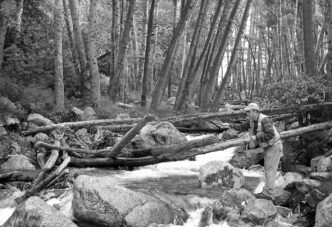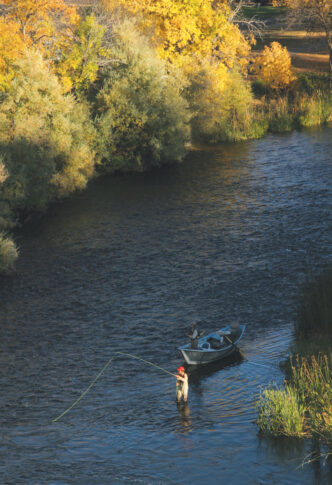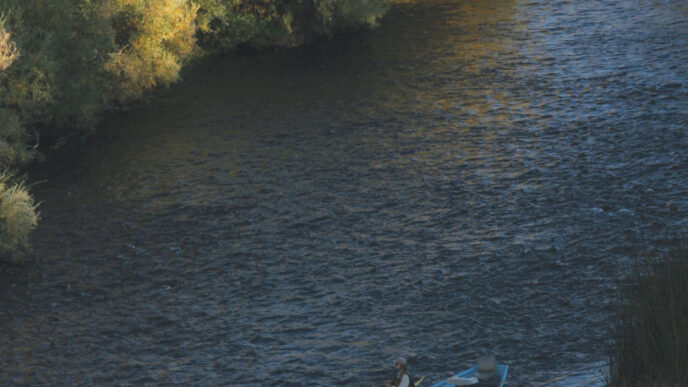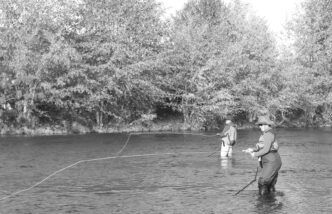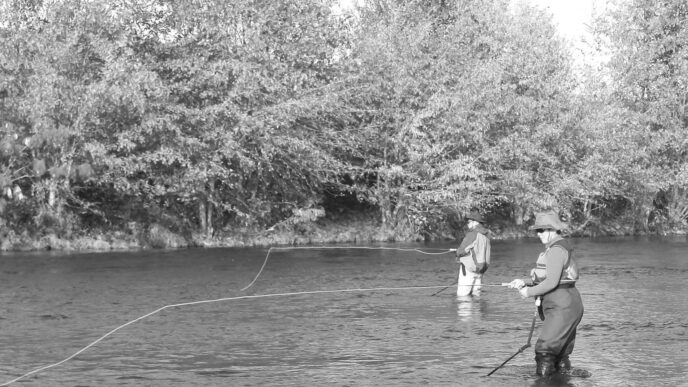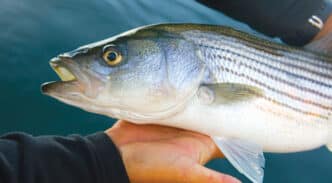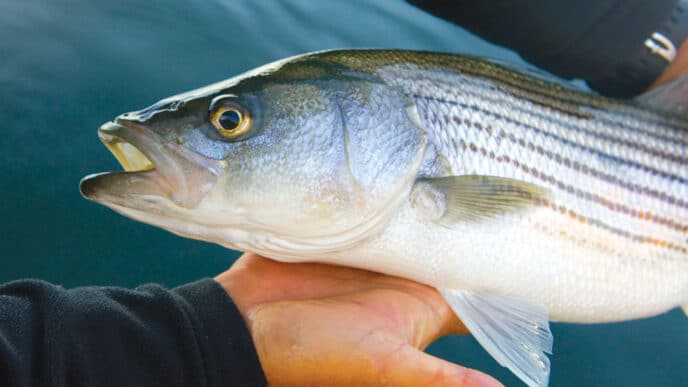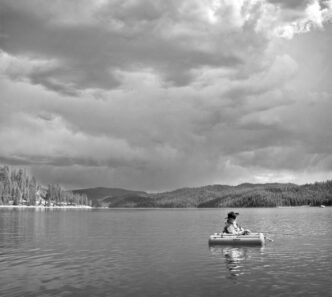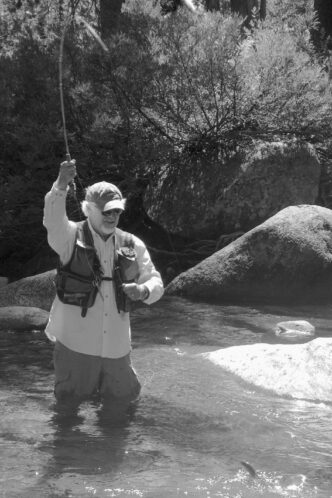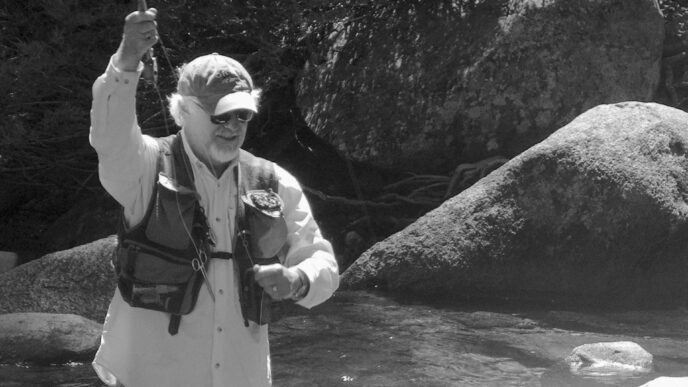The south-facing slope of the mighty San Gabriel mountain range looks down on one of California’s most congested urban complexes. Jam-packed with people and laced with freeways, the greater Los Angeles area and the Inland Empire combine to create a metropolitan area that is vast indeed and not often thought of as a place where you might find yourself casting a dry fly over a willing trout within an hour’s drive of most of it. There is more to this area, however, than first meets the eye.
From the Inland Empire cities of Rancho Cucamonga and Ontario on the east end of this rugged set of high peaks to Los Angeles itself, the San Gabriel Mountains hold a surprising amount of trout water. Some of the streams, such as the West and East Forks of the San Gabriel River, which I reported on in the previous issue of California Fly Fisher, are well known to both fly anglers and everybody else. San Antonio Creek, lying just north of the communities of Ontario, Upland, and Claremont, is another relatively high profile stream, one that straddles the Los Angeles–San Bernardino county line and offers roadside access and angling.
The Character of the Water
Very much a roadside stream, San Antonio Creek is situated in the same canyon as the paved road that runs up to Mt. Baldy Village and the ski resort there. Access is fair over much of the length of this stream, and because it starts high in the San Gabriel range and runs almost into the flatlands at the base of the mountain chain, some part of it provides decent fishing — despite the extremes of summer heat and winter snow — all year long.
The canyon that contains both Mt. Baldy Road and San Antonio Creek is steep and brushy, a typical Southern California chaparral-choked, south-facing slash in the face of the mountains. The stream runs primarily on the east side of the road and is reasonably accessible at several points up the canyon. The first is where Mountain Avenue crosses the stream at the Forest Service fire station, low down in the canyon in sight of the dam at the flood-control basin. You can park there and fish either upstream or downstream.
Higher in the canyon, another good access point is Barrett-Stoddard Road, where a Southern California Edison hydroelectric plant is positioned. You’ll find a parking area there, and it’s a short walk to the steam. Like most portions of San Antonio Creek, the need to clamber over boulders and climb around blow-downs and deadfalls of timber make negotiating the waterway a challenge. Along some parts of this stream, you’ll do more climbing than fishing.
There are many other potential access points, most of which will probably require a bit of exploration to find. These lead off the main paved road, and as you drive it you will see side roads and trails in a number of locations. Some are gated and lead into private property, while others are Forest Service routes and open to the public. I would take the time to obtain an Angeles National Forest map from the visitors center in Baldy Village. And you might want to carefully examine the area on Google Earth. Although Google Earth does not show San Antonio Creek well, it does indicate where the roads and trails are, and you can follow the route of the stream fairly well if you’ve traveled the main road a time or two.
Much of the stream below Mt. Baldy Village is in steep canyon country well away from the edge of the road, and you will have to expend some energy to get to the spots that offer the best angling. As with all Southern California trout streams, these spots are the places most people don’t want to make the effort to reach.
This year, San Antonio Creek is flowing quite well, so it is perhaps not the stream you will find in other years. Small streams in the Southern California mountains will flow strongly during the spring run-off, then decline sharply into the summer and fall.
Even in a wet year, you can fish San Antonio Creek without wading much, if at all. Unless you want wet feet, though, a pair of knee-length boots or hip waders is probably a good idea, at least in the spring. My friend Jim Matthews, an outdoor writer and lover of small trout streams who lives in San Bernardino, often totes along a pair of simple farmer’s-style knee boots, which suffice to get across the shallower sections of these little streams and yet don’t add weight or hold in much body heat.
I would also recommend a wading staff or hiking stick be a part of your San Antonio Creek kit. The stream is not deep, but it is rocky, and having that third point of balance is handy, especially for us older anglers. If you are lucky enough to have a staff with a small hook on the top, it is also handy for retrieving the flies you’ll hang in the ever-present brush and trees that crowd the creek channel.
Beginning high in the steep canyons between Mount San Antonio and Telegraph Peak, San Antonio Creek is not a big water, but rather a freestone stream of modest size that plunges down quick de-scents and burbles over short, rocky flats. It holds a mixture of rainbow and brown trout. None are giants, but they are beautiful wild fish, full of fight and life, and well worth a day’s fishing. Jim is of the opinion that the numbers of fish in this and other local streams are at least partly because of the highly successful Trout in the Classroom Program touted by the Federation of Fly Fishers and many local clubs.
I could not find which club, if any, was putting their class-raised trout into San Antonio Creek — and in recent months, there’s been a legal roadblock to stocking such fish while a court case and environmental surveys work their way through the system. Overall, the Trout in the Classroom Program is a success for conservation, and I hope it continues without being impeded by the courts.
Fishing San Antonio Creek
Jim Matthews and I visited the stream in May, spending most of a cloudy and drizzly day checking various parts of the canyon. It was the typical “June gloom” kind of day that settles around the south facing slope of the San Gabriels in the late spring. A persistent onshore breeze brings low clouds and fog in from the Pacific Ocean, and this packs into the canyons and creates overcast conditions almost every morning for several weeks. It actually improves the fishing most of the time and certainly keeps the spring heat down in the canyons.
We checked out the water along one heavily traveled section of trail, which proved unproductive, then fished San Antonio Creek alongside the road. The tipoff to where to fish was a New Zealand mud snail warning sign and an anglers report box positioned beside the pavement.
It was still raining lightly, but under the tall trees that arched over the stream, I felt almost as if I was in a cathedral, with soaring branches high overhead (unfortunately not quite high enough to prevent having a fly or two snatched on back casts). The spring flows were plunging down the canyon, filling pools to the brim with fast, swirling water. On his second cast, Jim hooked a dandy little rainbow that jumped once and thrashed around its pool as if larger than it really was.
While I shot a few photos, Jim caught and released a couple of other fish, one larger, in perhaps the eight-inch range, and one much smaller. The larger fish was a fat and spunky brown, while the other was an equally well-conditioned rainbow. I began to wish for two things. One was that I had uncased my rod and brought it down from the truck and the other was that the rain would stop falling on my camera and dripping down my neck.
After a few more casts and another small but brilliantly marked rainbow had fallen prey to Jim’s casting, we decided to call it quits, go in search of some coffee, and rethink where we would fish. We stopped at a local inn for a chance to sit in front of its big fireplace and talk with the guy behind the bar in the tavern. He fished the area, although not with flies, and we swapped stories and watched through the large picture windows as quail and bandtail pigeons came to the bird feeders in the back. The coffee was poor, but the conversation was good. We learned a couple of spots to try, and no, I won’t tell you where.
Flies and Tackle
One of the things I like about San Antonio Creek is that you don’t have to be too choosy about fly patterns. The main point is to fish something you can see. San Antonio Creek is small and, in places, relatively fast, and a dry fly will work almost anywhere here at almost any time save the dead of winter, perhaps. A selection of generic dry flies should do the trick.
Joe Perkins, a fellow member of the Deep Creek Flyfishers and an employee of a local tackle shop, noted that he likes to use tiny midges in size 20 or so on San Antonio Creek, but freely admits that most of the ordinary flies will work. He’s fished this stream quite a bit and thinks it is a pretty fair water. I agree.

“An Adams, particularly a Parachute Adams, is a good fly,” Joe said. “You don’t have to get there early. Wait until the hatch starts coming off. Anything that looks like a caddis or a mayfly will get hit.” I have to second that idea. Jim and I didn’t arrive on the stream until midmorning.
I would add to Joe’s recommendation of a Parachute Adams such ordinary patterns as a Humpy in the smaller sizes, and imitations of beetles and black and red ants. One of the better flies for the little streams in the San Gabriel and nearby San Bernardino mountains is an Elk Hair Caddis. Joe advised trying these in black, although the few tiny caddisflies that I saw hatching on my last trip were all a light tan color that stood out well against the green of the surrounding brush. They seemed to be about a size 18.
I’ve always felt that these small streams deserve a fly that floats well, and because aging eyes find it harder to pick up the fly on the water, I’ve grown to favor flies with a bit of color on top to aid in tracking them through the quick twists of current around the rocks and over the tiny waterfalls of the pools. Various foam fly patterns with a bit of bright red or yellow foam on top provide an elegant solution to the problem of finding a fly that floats well and is visible. The same is true of the Bivisible, with its white front hackle, and the Renegade — both of which will float high in the turbulent water. Sizes up to 14 are useful, although size 16 and down will likely get more strikes. Jim, however, managed to catch a couple of fish on a stonefly nymph that was about a third the length of one of the smaller fish. They ain’t picky.
Joe also noted that he likes fishing a 6-foot 2-weight rod on these small, brushy streams, and I second that idea, too. My current rod of choice for San Antonio Creek and many of the other little streams and creeks in the local mountains is a 6-foot 3-weight rod with a tiny reel that barely holds half of a double-taper fly line and a bit of backing. Anything much heavier would seem to be overkill, although Matthews fished an 8-foot 3-weight on our last trip without finding too many lurking tree branches to snare an errant back cast.
You could easily handle the vast majority of the fish you’ll catch on a very light tippet, and indeed, a 5X tippet neatly matches the size of the flies you’ll probably use, although I recommend a 4X tippet, mostly because the fish don’t care, and it’s easier to get your fly back from the clutches of sneaky bushes and trees that creep up behind you while you are casting. San Antonio Creek isn’t a major fishery. It is a minor one that offers sport for the angler who wants to catch smaller wild trout on light gear. A 10-inch trout in this stream is a whopper, and the climbing and crawling you’ll have to do to reach the best water is probably more than some will want to undertake. On the other hand, the drive for most Southern Californians is easier than a jaunt to the Sierra, and, if you can get away on a weekday, the stream offers a fair amount of solitude for those willing to hike away from their vehicle.
If You Go…
From the 210 freeway, take Mountain Avenue north through the San Antonio Heights area and up Mt. Baldy Road. While much of San Antonio Creek flows through a steep canyon some distance from the main paved road, there are side trails and dirt roads that lead to the water. You’ll have to search them out for yourself.
San Antonio Creek is under general regulations, with a five-fish limit, but I would recommend catch-and-release angling to protect these wild trout. A change in the regulations this year means you don’t have to wear your fishing license visible on the outside of your clothing. On the other hand, you will need an Adventure Pass to park your vehicle off the highway along San Antonio Creek.
There are a few places to eat in Mt. Baldy Village and at the ski area above it, and a broader selection of restaurants is available not far away in the communities of Claremont, Upland, and Ontario. One of the author’s favorites is Kishi’s Japanese Restaurant, 320 Foothill Boulevard, Upland; phone (909) 981-1779. You can also get lunch at the Bass Pro Shop in Rancho Cucamonga while you visit the fly shop: 7777 Victoria Gardens Lane, Rancho Cucamonga; phone (909) 922-5500. For more information on the area and details on the Angeles National Forest, check with http://www.fs.fed.us/r5/angeles or stop by the Mt. Baldy Visitor Center, Mt. Baldy Road, Mt. Baldy; phone (909) 982-2829.
Richard Alden Bean



